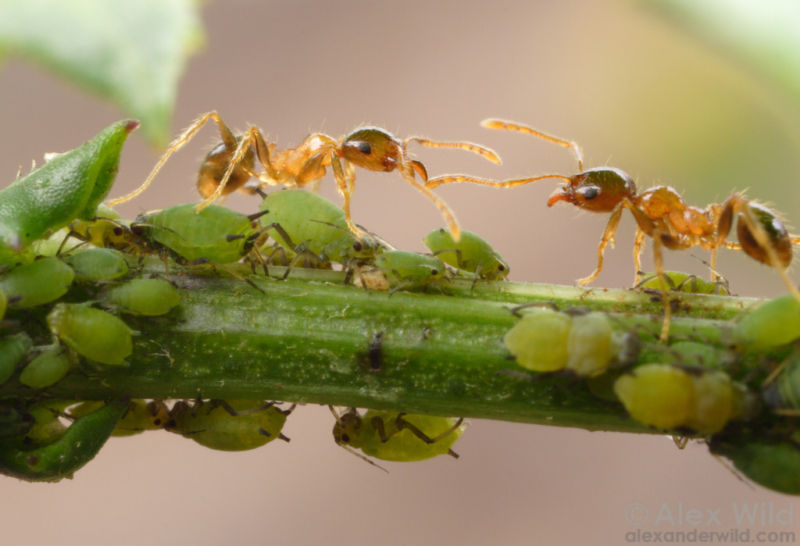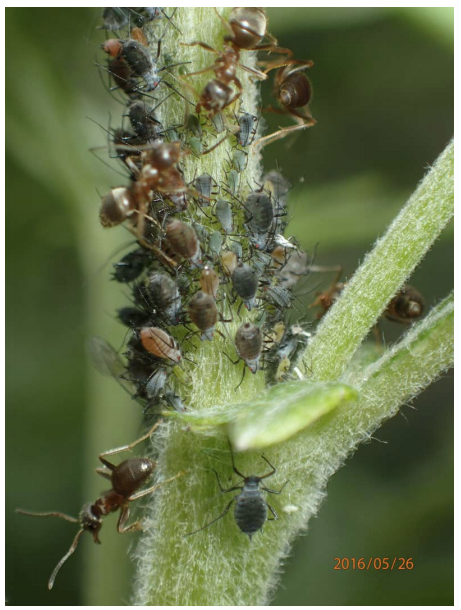
One of the worst effects of ant infestation doesn't happen inside your house or on your picnic blanket. It takes place in farms and gardens, where many species of ants tend to herds of aphids. These tiny insects are a bane to plants—aphids weaken plants by feeding on their sap, and they sometimes transmit deadly viruses while eating. This has earned aphids the nickname "plant lice." But for ants, aphids are more like cows. They secrete a sugary fluid called honeydew that ants love to eat.
Aphid ranchers on the mugwort frontier
Just as humans have transformed millions of acres of open land into ranches for cattle, ants can easily transform fields into aphid ranches. A new study by a group of environmental scientists in Japan reveals that ant cultivation of aphids isn't a haphazard process, either. Researchers in Science Advances describe an experiment where they discovered that ants in a Hokkaido field are often the only factor that prevents aphid colonies from going extinct. In addition, the ants prefer aphid colonies with a nice balance of green and red aphids, and they select aphids to exhibit these colors.
Even though many ant species tend aphids and similar sap-eating insects, the researchers focused exclusively on ants from the species L. japanocus. These ants tend colonies of the species M. yomogicola, a kind of aphid that feeds on the mugwort plant. The researchers identified three groups of eight aphid colonies for observation. They left one group alone to be tended by ants, while another group was isolated from their ant benefactors by painting the base of their mugwort homes with a sticky substance called Tanglefoot that prevents ants from climbing the stalks to their herds. The third group was a control, tended by ants, but exposed to a minimal amount of Tanglefoot. This was just to measure the effect of Tanglefoot on aphids (it was negligible).The results were stark. All but one of the aphid colonies that were not tended by ants went extinct. Of the surviving aphid colony, only one aphid remained. Without ants to protect them, the aphids were eaten by predators like ladybug larvae and parasitoid wasps. Apparently, ants remove these predators from their herds when they come to milk the aphids for honeydew. The ants win, the aphids win, but the mugwort suffers. A version of this scenario plays out all over the world, where ant invasions often mean aphid invasions, too.
Long-term planning

Ants simply seem to prefer tending herds with a relatively balanced number of greens and reds. Because aphid colonies tended by ants have a much higher survival rate than ones without ants, it seems likely that selection pressure for this color polymorphism comes directly from ant shepherds.
The question is why do ants like this color balance? One possibility is that red and green aphids have slightly different effects on the mugwort plants where they feed. Though green aphids produce more honeydew, reds seem to prevent the mugwort from flowering. Given that aphid colonies on a flowering mugwort go extinct, ants looking to maintain a herd for more than a year might see an advantage to keeping reds around to guarantee a long-term food supply from their green sisters.
It appears that ants aren't just opportunistically squeezing honeydew out of any old aphid colony. They are deliberately maintaining aphid herds, possibly for many seasons, by carefully selecting for a ratio of red and green insects. This kind of long-term planning guarantees herd longevity and, ultimately, a good food supply for the ant colony. It's just another way that ants are uncannily like humans, both in their quest to convert land into farms and their undying love of sugary fluid from dubious sources.
Science Advances, 2016. DOI: 10.1126/sciadv.1600606 (About DOIs)
reader comments
85